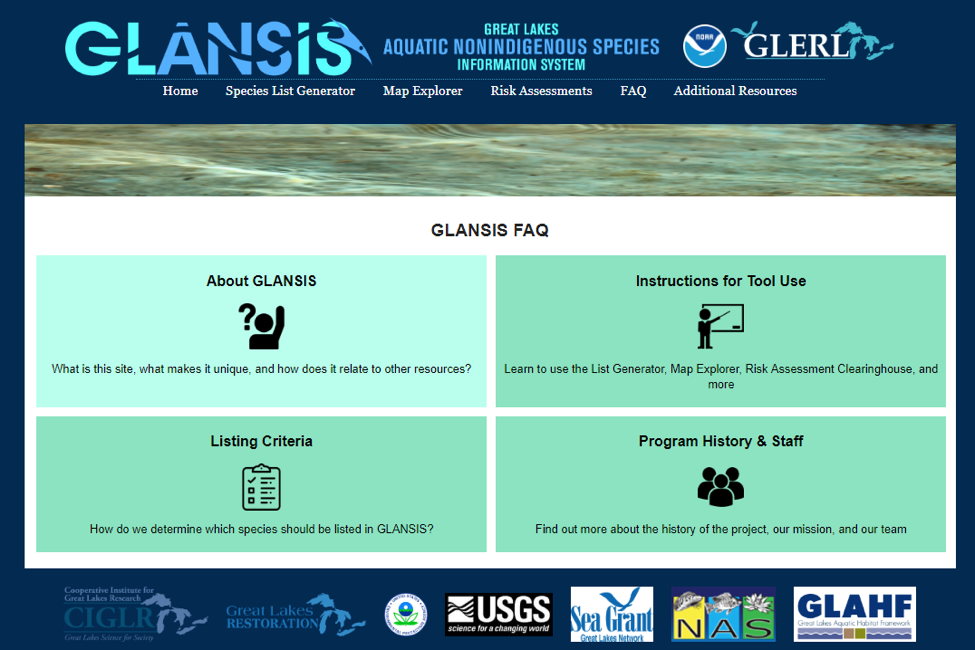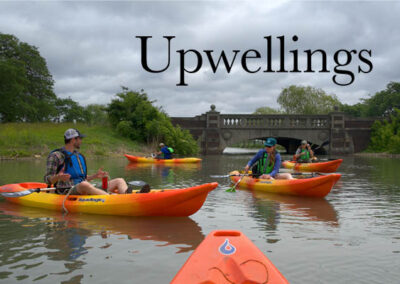Website redesign adds new tool which provides side-by-side comparisons of risk assessments for individual aquatic species and more.
By Rochelle Sturtevant, Michigan Sea Grant, Michigan State University Extension, and El Lower, CIGLR Research Associate

The redesigned database features a tile layout that links to previously featured tools like the Species List Generator and the Map Explorer, along with the recently debuted Risk Assessment Clearinghouse.
For more than a decade, the Great Lakes Aquatic Nonindigenous Species Information System (GLANSIS) has provided scientists and stakeholders with a toolkit for identifying and managing aquatic invaders in the Great Lakes. In addition to a new suite of tools and assessments, the GLANSIS site has recently rolled out a whole new look — a redesign directly shaped by user feedback.
The redesigned database features a tile layout that links to previously featured tools like the Species List Generator and the Map Explorer, along with the recently debuted Risk Assessment Clearinghouse which provides side-by-side comparisons of risk assessments for individual species, the respective methods used to produce them, and access to full bibliographies of relevant risk literature.
More new features
Other new additions include a Frequently Asked Questions section (which includes instructions for tool use, the criteria the GLANSIS team uses for whether a species should be included in the database, and the history and legacy of the program), as well as a user contribution portal (where researchers can share their own verified reports of species sightings, identification photos, general feedback about the site, and participate in peer review).

Reworking the database to make it more accessible and user-friendly was a priority for the GLANSIS team. After identifying the different stakeholder groups who used the database, the team distributed a survey to environmental scientists at the International Association for Great Lakes Research (IAGLR) conference in June 2018 to determine what kinds of information they utilized most frequently, along with which parts of the site they liked, and which could use some improvement. This survey was followed by a series of usability tests with environmental managers and communications specialists, who walked through the site page-by-page with the GLANSIS team to share feedback on content, formatting and layout. The team used these responses to guide a redesign emphasizing easy navigation, straightforward instructions for tool use, and a host of new features to help users take full advantage of all the information resources provided. Working directly with stakeholders and allowing user needs to shape the redesign process was key to ensuring that GLANSIS provides information in a format that is most accessible to users and best meets their specific information needs.
The new website debuted at the 2019 IAGLR conference in Brockport, New York, and was featured in a session on stakeholder engagement in the Great Lakes region.
Explore the site
You can explore the site yourself at www.glerl.noaa.gov/glansis. If you have further suggestions or feedback about the site, please feel free to get in touch through the Contribute portal. We would love to hear from you.
Michigan Sea Grant helps to foster economic growth and protect Michigan’s coastal, Great Lakes resources through education, research and outreach. A collaborative effort of the University of Michigan and Michigan State University and its MSU Extension, Michigan Sea Grant is part of the NOAA-National Sea Grant network of 33 university-based programs.
GLANSIS is a NOAA-led clearinghouse of ANS information for the Great Lakes region and a Great Lakes regional node of the USGS Nonindigenous Aquatic Species (NAS) database. This article was prepared by Michigan Sea Grant Extension under award NA17OAR4320152 from the National Oceanic and Atmospheric Administration, U.S. Department of Commerce through the Regents of the University of Michigan. The statements, findings, conclusions, and recommendations are those of the author(s) and do not necessarily reflect the views of the National Oceanic and Atmospheric Administration, the Department of Commerce, or the Regents of the University of Michigan. This project was also supported by the Great Lakes Restoration Initiative.


